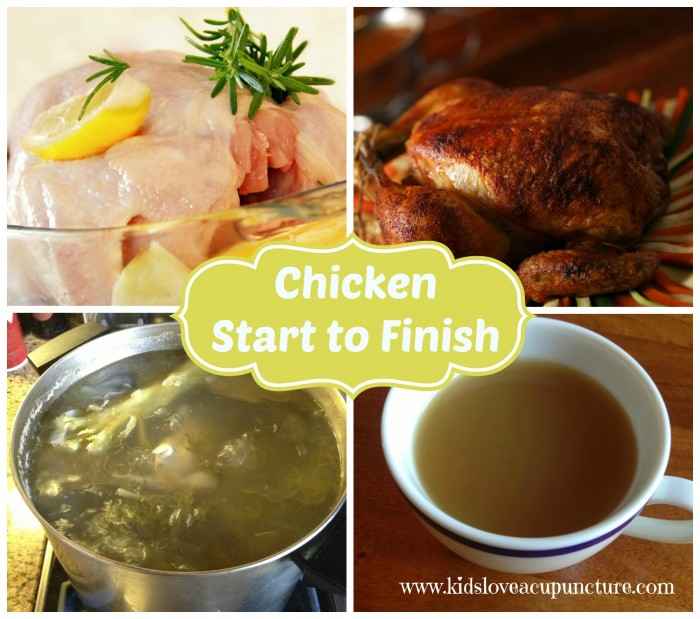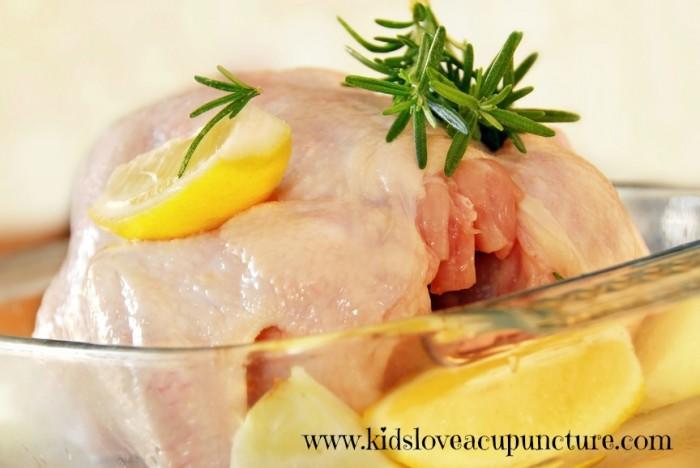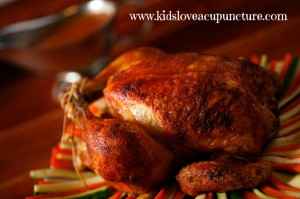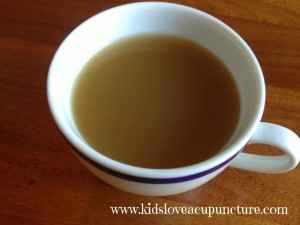Chicken Start to Finish: Roasted Chicken & Bone Broth Recipes

If you’ve read any of my previous blog posts you’ve probably noticed that I often recommend adding bone broth to your child’s diet to support healing. Traditionally prepared bone broths are full of nourishing ingredients that help support the immune and digestive systems. It is revered in Chinese culture for it’s healing properties, referred to as “longevity soup,” and is an age old remedy for any type of infirmity. It is given to the young and old to help support their body’s special needs. The nutrients and minerals in bone broths are easy to assimilate making this remedy a staple in healing many different illnesses, broken bones and poor muscle development. Bone broth is rich in collagen, gelatin and minerals which according to traditional Chinese medicine (TCM) help to promote proper digestion, stop dry coughs and treats insomnia and irritability related to high fevers (1). In cultures that consume little or no dairy products, bone broths were a major source of calcium and magnesium before modern processed foods became the standard. Sadly, boxed and canned broths are highly processed and contain ingredients like hydrolyzed yeast extract, msg, corn syrup and other additives plus a large amount of sodium. There is no substitute for homemade broth made from the bones of a healthy pastured chicken so I wanted to share how we make broth from start to finish at our house. My husband, Dwight, is the main chef in our family (lucky, right?) and I’ve asked him to share his recipes for roasted chicken and bone broth. Here’s what Dwight (who can also be found at http://bookcents.blogspot.com/ here) does with the pasture-raised chickens I bring home from the farmer’s market.
Chicken Start to Finish:
Roasting the chicken These types of chickens are smaller in size and weigh less than your normal, store-bought chickens. The ones we have bought so far are around 4 pounds. Rinse and pat dry the chicken. Season the cavity with salt and pepper and place in a roasting pan. Melt 2 Tbsp. butter and mix with 2 Tbsp. olive oil. Brush the mixture over the chicken. Salt and pepper the chicken. Roast for 75 minutes (longer if your chicken weighs more) in the center of a 400°F oven, basting with pan juices often, until a meat thermometer registers 175°F in the thigh meat. While the chicken cools enough to carve, pour the pan juices and browned bits into a saucepan and simmer until thickened.

Variations: Have fun putting lemon halves, chopped onions, or your favorite herbs (thyme, rosemary, etc.) in the cavity. Discard them before carving. Or add fresh herbs, lemon juice, garlic, white wine, or your favorite seasoning to the butter/oil mixture and brush over the chicken.

Bone Broth This recipe is adapted from Nourishing Traditions by Sally Fallon with Mary G. Enig (Washington, D.C: NewTrends Publishing, Inc., 2001). Take the bones and any parts of the chicken not consumed (tips of the wings, giblets, etc.) and put in a stockpot. Chop a small onion, two carrots, and three celery stalks and add to the stockpot. Pour in one gallon of water and add 1 Tbsp. of white or apple-cider vinegar. Place the stockpot on the range and turn the temperature to medium. Once the water approaches a boil cover the pot and turn the heat down so that a low simmer is maintained. Simmer for 16-24 hours. After the stock has cooled, strain the broth of all solids. You can strain the fat off or refrigerate at this point and remove the hardened fat later. If you don’t think you will consume the stock over the next couple of weeks, pour some into ice cube trays—the frozen cubes of stock provides a quick and easy addition to any dish. Variations: I like to add a piece or two of chicken (not necessarily from the one just roasted) to the pot for additional flavor. Be sure and save your bones from other dishes and add to the pot—I throw the discarded bones in the freezer until we make a batch of the stock. Discarded parts of vegetables, such as the greens of leeks or carrots, can add additional flavor and richness. Keep in mind that with the long simmer time a little addition goes a long way. Add other vegetables to the pot that you like or want. Chopped fennel, for instance, is a good addition for women that are lactating.

This post was shared on:
Thank Goodness it's Monday from Nourishingjoy.com
TALU Tuesdays from Wrinkledmommy.com
Party Wave Wednesday from Holisticsquid.com
Real Food Wednesday from Kellythekitchenkop.com
Whole Food Wednesdays from Wholelifestylenutrition.com
Old Fashioned Friday from Ourheritageofhealth.com
Sunday School from Butterbeliever.com
Let's Get Real Friday Party from Jugglingrealfoodandreallife.com
Simply Natural Saturdays from Pistachioproject.com
Disclaimer
Categories
- AcuParenting™ (26)
- The Unwellness Gap™ (11)
- Resolving Illness (10)
- Chinese Medicine Wisdom (20)
- Health Conditions A to Z (16)
- Healthy Eating (10)
- Healthy Guts (5)
- Natural Remedies (11)
- Non-Toxic Living (1)
- Acupressure and Massage (16)
- Mindfulness and Gratitude (1)
- Recipes (5)
- Podcast Interviews (3)
- RRG TV (4)


2 comments
Leave a comment